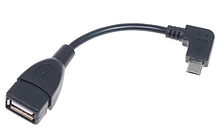

USB On-The-Go (USB OTG or just OTG) is a specification first used in late 2001 that allows USB devices, such as tablets or smartphones, to also act as a host, allowing other USB devices, such as USB flash drives, digital cameras, mouse or keyboards, to be attached to them. Use of USB OTG allows devices to switch back and forth between the roles of host and device. For example, a smartphone may read from removable media as the host device, but present itself as a USB Mass Storage Device when connected to a host computer.
USB OTG introduces the concept of a device performing both Host and Peripheral roles – whenever two USB devices are connected and one of them is a USB OTG device, they establish a communication link. The device controlling the link is called the Host, while the other is called the Peripheral.
USB OTG defines two roles for devices: OTG A-device and OTG B-device, specifying which side supplies power to the link, and which initially is the host. The OTG A-device is a power supplier, and an OTG B-device is a power consumer. In the default link configuration, the A-device acts as a USB host with the B-device acting as a USB peripheral. The host and peripheral modes may be exchanged later by using Host Negotiation Protocol (HNP).
The wiring for the ID pin defines the initial role of each device.[1]
- ^ Koeman, Kosta (22 November 2001). "Understanding USB On-The-Go". edn.com. EDN. Retrieved 20 June 2017.